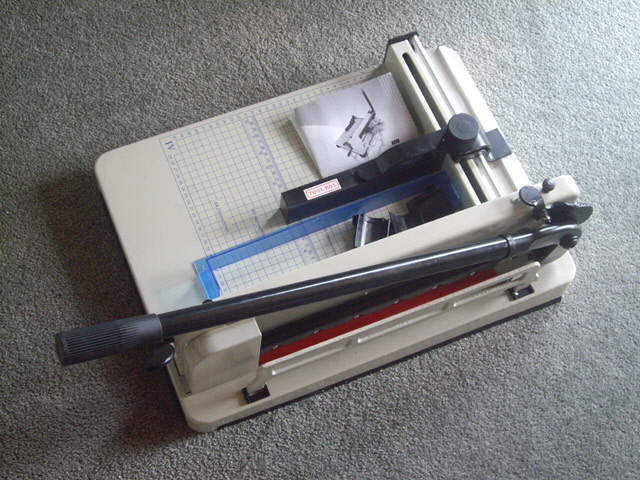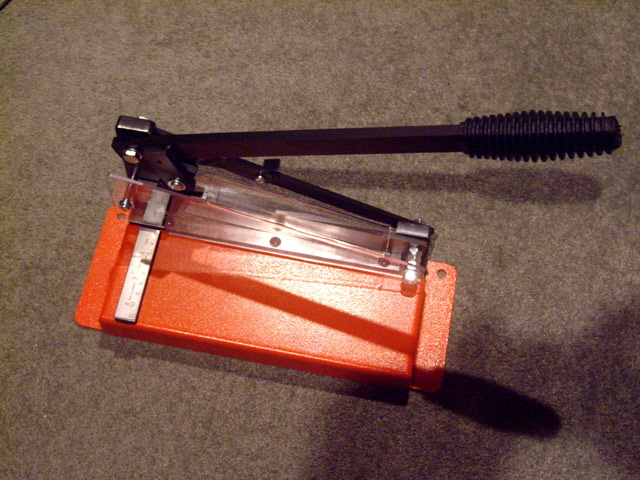|
There is just one more nice-to-have for PCB making, and that is a guillotine. Sure you can use a hacksaw or hand shears, or a power saw, and even scour and snap, but these techniques all have problems including rough edges, excessive board flex, corner delamination, surface damage, dust, accuracy, time, power and so on.
The only hassle with a guillotine is cost. But after a bit of research I have found a robust low cost (US$230 including freight and tax) A4 paper guillotine that will apparently cut up to 600 sheets of paper. Paper is actually remarkably tough on blades so I expect that the machine will give good duty on 1.6 mm thick double sided FR4 board. Sure, the boards may eventually be vee notch or mill cut to final shape but with a suitable guillotine I should be able to get nice rectangular blanks for board manufacture in just a few minutes, and if necessary I can trim the boards to final size with the guillotine and save a whole machining step.
As an aside this guillotine should also be quite suitable for thin (say up to 1.2 mm) soft sheet materials such as plastic and aluminium. The guillotine is on order and I’ll review it when it arrives in about a week.
Oops, there has been a problem with the guillotine and it has ended up in Australia. The issue was an administrative mix-up between me and the supplier. I’m working with the courier company to redirect the consignment, but this will take some time to sort out.
The guillotine arrived today after its sojourn to Australia. The base has been severely damaged during its travels and the precision blade already has some chips on the cutting edge. The machine comes complete with bits of metal swarf from manufacture (not good). The blade retention is just eight small machine screws into a folded steel channel (not very robust in my opinion). And the locking lever is pretty shoddy and rattles although it does work. The paper clamp has a nice action on paper but will not hold circuit board securely under blade shear.
The blade shear action just doesn’t look right for anything other than paper. In essence the blade is almost parallel with the upper face of the work and slices like a razor blade being drawn across the surface under the significant downward pressure exerted by the lever action. The blade does not act against an opposing edge like a pair of scissors, but against a flat plastic plate. For PCB and metal work I’d expect to see a rolling angle of about 10 degrees between two mating edges.

Figure 1. Paper Guillotine
(Great for paper but completely useless for PCBs.)
I removed the blade and ground the edge back to sharp with an oil stone. There are still two chips but removing these by hand will take forever. With the blade re-fitted I tried the guillotine on a 10 mm stack of paper and it cuts this quite well although the bottom sheet or two don’t always cut clean. I figure this will probably come right as the blade eventually beds into the plastic plate.
I tried the guillotine on a small piece of 0.8 mm thick single sided phenolic board. It didn’t cut at all. The blade simply scoured the upper side of the board and eventually the board fractured. So this paper guillotine won’t cut circuit board (or plastic or metal sheet) and it has been assigned to the office for cutting paper.
In essence this experiment was a failure so today I have ordered a slightly more expensive guillotine that is specifically designed for sheet metal and circuit boards. The new guillotine arrived in just a week (all the way from England) and it cuts PCB’s (FR4 and phenolic) like a hot knife through butter with absolutely clean cut edges that are dead square to the guide.

Figure 2. Metal Shear
(Fortex Engineering)
The 8” (200 mm) blade length will be just fine for all most of of the circuit boards that I design, and suits the dimensions of my CNC Mill capacity nicely. We are another step closer to an improved prototype PCB making process and the office has a brand new paper guillotine too!
|